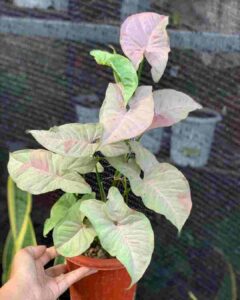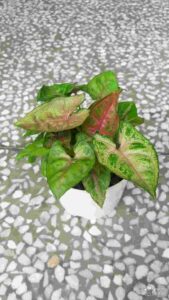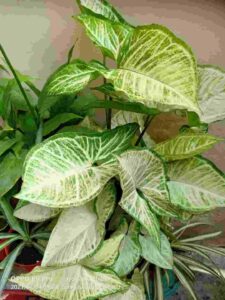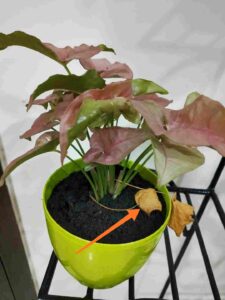Syngonium Pink
If we talk about the indoor houseplants and not mention Syngonium, then – it will be an injustice because it has wide varieties, leaves are beautiful, grows in minimal care, can be grown as vine and has many colours. In this blog, we will be discussing its beautiful variety having pink leaves called, Syngonium Pink.

It is grown for its colourful foliage beauty. It can be easily grown in medium sized pots. It is a summer plant and more pink leaves appear during the summer season. The plant is native to tropical rainforest of West Indies, Bolivia, Brazil, Mexico, and Ecuador.At present, It is distributed all over the world and is popular among gardeners. The plant can be easily grown in hanging baskets. This plant is evergreen, hardy, grows easily and can attain a height of (3-6) ft with 2 ft width.
It is known as the arrowhead plant, Arrowhead vine, Arrowhead Philodendron, Arrowhead Ivy, Nephthytis, African Evergreen, American Evergreen, Syngonium Pink Allusion and Goosefoot plant. The scientific name of the plant is Syngonium podophyllum. The reason for calling it an arrowhead plant is because the mature leaves resemble an arrow.
All syngonium are air purifying plants. Therefore, It is beneficial to grow it in our home. Check another perfect and cute home plant, Stone Lotus Flower
Syngonium Pink Varieties
Many people in America keep this stunning plant in their home because they have many varieties to choose from. Different colours with different patterns in leaves are found. Some are dwarf with small leaves while some are large, becoming vine with large leaves. Green, Pink and Cream colour Varieties are found. Some Varieties of Syngonium are listed below:-
✓P. Syngonium Splash
✓P. Syngonium Perfection
✓P. Syngonium Hybrid
✓P. Syngonium Marble
✓P. Syngonium Variegated
✓Syngonium Dark P.
✓Syngonium Pink Allusion
✓Neon robusta
✓Syngonium Mini
Note: P – Pink
Propagation

If you grow syngonium Pink for one time, Then – you don’t need to buy it again as it can easily multiply. The plant can be propagated during the month of July to Sept. Propagation is easy. We can propagate this plant by two ways:-
1. From Leaves
Leaves appear in vines. There are nodes in the vine. The leaves emerge from each node. Cut the leaf along with its petiole and node. Now, Keep it in water inside a glass vessel. Change the water every 5 days. After around 15 days, roots emerge. Now, You can transplant it into a pot by preparing a good soil mix. After propagation, Water it thoroughly.
2. From Root Division
Some Varieties or old syngonium have more stems. Each stem contains a leaf. Take a plant out of the pot and separate stems along with roots and leaves. Now, Transplant it to another pot with a good soil mix. Water it thoroughly. Check another easy to grow plant, 9 O Clock Flower.
Syngonium Pink Care
Location
It is a great indoor plant. You can keep it in your room, dining hall, study table or anywhere you want but keep it near the window. East or North facing windows will be an ideal location.
Soil Mix
Medium textured soil with pH (5.5-6.5) is best suited for the plant. Soil should be well drained. As it is a fleshy plant and can store water. (6-8)inch pot size is enough for this plant.
Adding charcoal pieces in soil mix will add in drainage, prevent fungal infection and also provide nutrients. The soil mix for Syngonium Pink is given below:-
1 Part Sand , 1 Part Garden Soil, 1 Part Cocopeat, 1 Part Vermicompost
Temperature
Temperature (15-30) ° C is good for Pink Syngonium. This temperature will help to grow more foliage with vibrant colours. Lower temperature will cause stunted growth
Watering
Watering should be done when the top layer of soil is dry. Moderate watering should be given. Moist but not soggy. Water lodging should be avoided. Make sure the drainage hole of the pot isn’t blocked due to soil accumulation. Otherwise, There will be too much moisture which can leads to rotting of roots and ultimately the plant will die. Young syngonium Pink requires less water than mature plants. The plant is slightly tolerant to water stress. So, You don’t need to worry if you miss a day. However, If dry period continues for a few days, Lower leaves will get dry and brown.
Humidity
As it is tropical in Origin, It loves humidity. So, Some people keep it on their bathroom window. (40-50)% humidity is ideal for this plant. You can use bottle spray to maintain humidity.
Sunlight
As the summer commences, the pink colour of the syngonium becomes deep which makes it more attractive. Pink syngonium loves filtered bright sunlight. Too much sunlight will cause burning of leaves. Other varieties should be kept in shade. Plants which haven’t received enough sunlight have green leaves with white tint. In short, (3-4) hours of filtered bright sunlight is ideal for this planet. Dark places should be avoided.
Fertilizer
As it is a leafy plant, Nitrogen is mainly required. N P K fertilizer can be used by making solutions. Nitrogen helps to impart good colours in leaves. Homemade fertilizer can also be used like: Oil cake, Bone Meal, Ash, FYM, Fermented Banana Peels, Neem Cake. SSP can also be used as a phosphorus source. Liquid fertilizer and slow releasing fertilizer like Osmocate works great for houseplants.
Potting and Repotting
About 6 inch pot is enough. Repotting should be done during the dormant season. When the roots become pot bound condition then Repotting should be done.
Pruning
Regular pruning of syngonium will help to keep it in proper size otherwise they become lanky. To make it bushy, Vines should be pruned from base.
Price
The price of Pink Syngonium greatly varies from place to place. It also depends on the seedling age, colour and Varieties. However, The average price range is Rs (20-150) in India.
Common Problems In Syngonium Pink
1. Leaves Turning Green

It is disappointing to get green leaves even after growing Pink Syngonium. But, You might be making mistakes. Too much direct sunlight also causes leaves to turn green because of more chlorophyll formation and also keeping it in total shade also restricts the formation of pink leaves. Keep it in East facing windows receiving (4-5) hrs of bright filtered sunlight to get pink leaves. Young leaves have a green shade which turns to pink as they mature.
2. Dropping Of Leaves
When the Syngonium plant doesn’t receive enough water then, The leaves get flaccid and they start to droop. Therefore, Regular watering is essential.
3. Leaves Turning Brown

The cause of this is less water and more direct sunlight than required. Proper amount of watering and keeping it in filtered sunlight will solve the problem.
Pest And Diseases
Syngonium pink is resistant to pests and diseases. However, There might be a case of pest attack like Spider and Mealybugs. Neem Oil should be sprayed during pest attack. Insecticidal soap effective to control Mealybug. If you want to know the technique of making the insecticidal soap, then we have a detailed guide which you can read from :- Mealybug Control In Houseplants
Root Rot, Bacterial Blight, Stem Rot are common diseases which are caused by fungi and bacteria. Water logging should be avoided.
Is It Pet Friendly?
Though Syngonium pink is almost a perfect flower, it has poisonous properties. Therefore, It shouldn’t be eaten. The toxicity can cause an emergency if ingested. The plant contains calcium oxalate crystals which can irritate the lips, mouth, throat and tummy if ingested.
Benefits
- It is a NASA approved air purifying plant which is the most beneficial point.
- The beautiful foliage aids the beauty of any place.
- It can be easily propagated. So, No need to buy again and again.
- It is a perfect plant to give to relatives and friends.
- It can be grown without soil.
Final Verdict
Thus, Syngonium pink is that perfect plant every gardener is seeking for. You can grow it easily, So, I recommend you add this plant to your list.

